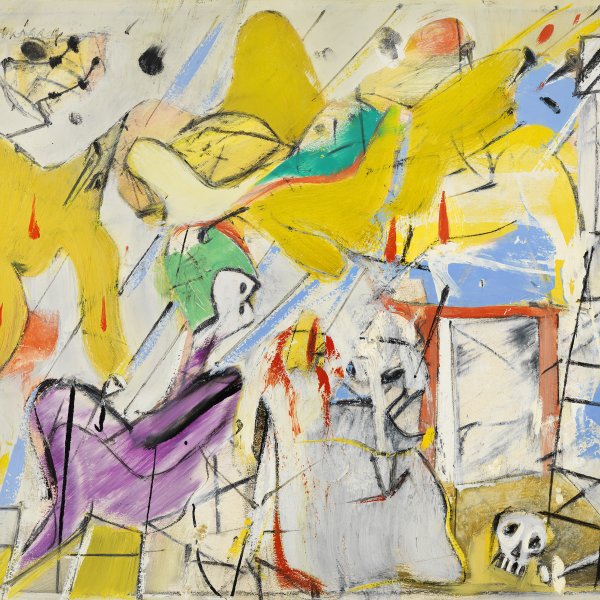Willem de Kooning
Rotterdam, 1904-New York, 1997
A representative of American Abstract Expressionism, Willem de Kooning blurred the boundaries between abstraction and figuration with his Action Painting, becoming an influential figure on the art scene of the second half of the twentieth century.
De Kooning trained at the Academie van Beeldende Kunsten in Rotterdam, his city of birth, worked in a decoration and advertising firm and travelled around the Netherlands and Belgium before arriving in the United States as a stowaway in 1926. He moved to New York in 1927 and soon met John Graham, Stuart Davis and Arshile Gorky. In 1936 the Works Progress Administration hired him to work on its art project and only then was he able to devote himself exclusively to painting. His initial abstract still lifes and depictions of male figures gave way to works centred on women in 1938, the year he met his future wife the painter Elaine Fried. These female figures trace the progressive evolution of De Kooning’s work, which had become more biomorphic from the end of the 1930s owing to the influence of Miró, Arp and Picasso. These first women paintings were shaped from increasingly fragmented uneven planes and surrounded by a geometrical background. Their unfinished nature and emphasis on drawing attest to the influence of Surrealism at this point in the artist’s career. Throughout the 1940s De Kooning took part in numerous group exhibitions with other artists of the New York School and in 1948 the Egan Gallery held his first one-man show. At the beginning of the 1950s he started on another series of women paintings in large format, which caused a sensation when they were shown at the Sydney Janis Gallery in 1953: on the one hand they were considered perverse and sexist, and on the other they were criticised for the figuration that De Kooning never entirely abandoned. From 1955 onwards, the women in his works gradually merged with the surrounding landscape, culminating in the series of Abstract Urban Landscapes.
De Kooning returned to his native country for the first time in 1968 for an exhibition the Stedelijk Museum in Amsterdam was staging of his work. While travelling around Europe he began to experiment with sculpture.
De Kooning trained at the Academie van Beeldende Kunsten in Rotterdam, his city of birth, worked in a decoration and advertising firm and travelled around the Netherlands and Belgium before arriving in the United States as a stowaway in 1926. He moved to New York in 1927 and soon met John Graham, Stuart Davis and Arshile Gorky. In 1936 the Works Progress Administration hired him to work on its art project and only then was he able to devote himself exclusively to painting. His initial abstract still lifes and depictions of male figures gave way to works centred on women in 1938, the year he met his future wife the painter Elaine Fried. These female figures trace the progressive evolution of De Kooning’s work, which had become more biomorphic from the end of the 1930s owing to the influence of Miró, Arp and Picasso. These first women paintings were shaped from increasingly fragmented uneven planes and surrounded by a geometrical background. Their unfinished nature and emphasis on drawing attest to the influence of Surrealism at this point in the artist’s career. Throughout the 1940s De Kooning took part in numerous group exhibitions with other artists of the New York School and in 1948 the Egan Gallery held his first one-man show. At the beginning of the 1950s he started on another series of women paintings in large format, which caused a sensation when they were shown at the Sydney Janis Gallery in 1953: on the one hand they were considered perverse and sexist, and on the other they were criticised for the figuration that De Kooning never entirely abandoned. From 1955 onwards, the women in his works gradually merged with the surrounding landscape, culminating in the series of Abstract Urban Landscapes.
De Kooning returned to his native country for the first time in 1968 for an exhibition the Stedelijk Museum in Amsterdam was staging of his work. While travelling around Europe he began to experiment with sculpture.






